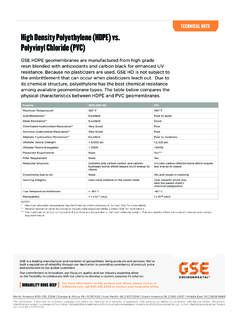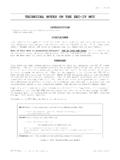Transcription of TECHNICAL NOTE Standard OIT vs. High Pressure …
1 NOTES tandard OIT vs. High Pressure (HP) OIT - HDPE & lldpe geomembrane stabilization SystemsOxidation degrades a geomembrane s mechanical properties over time. It is a chain reaction that can be initiated from energy sources such as elevated temperatures and UV radiation. stabilization systems are commonly added to polyethylene to prevent oxidation by intercepting the oxidation reaction with the polymer. There are many types of stabilizers that are active at different temperature levels. As long as there are stabilizers present, there should be no degradation of the geomembrane s mechanical properties. Although stabilizers are consumed as they interrupt the oxidation process of geomembranes, this is not the primary driving force for the depletion of stabilizers.
2 The surrounding air, water, or other chemicals extract the stabilizers from the geomembrane at a much faster rate than they are consumed by geomembrane protection. A high quality stabilizer system is designed to provide protection from oxidation while also resisting extraction by physical means. If the stabilization system is designed poorly, then it will be easily Information on OIT Testing ProtocolsThere are two ASTM testing proocols for Oxidative Induction Time (OIT). The first to have come into existence is ASTM D 3895 - 14: Standard Test Method for Oxidative-Induction Time of Polyolefins by Differential Scanning Calorimetry. The other test (developed after 3895) is ASTM D 5885 - 06 (2012) Standard Test Method for Oxidative Induction Time of Polyolefin Geosynthetics by High- Pressure Differential Scanning Calorimetry.
3 The two tests are essentially quite similar with one critical difference. A small sample of the material to be tested is placed in an apparatus that measures heat and energy extremely accurately. The apparatus is heated and at the appropriate time, oxygen is introduced into the system and the sample material begins to oxidize. This oxidation is suppressed by the stabilization system ; however, eventually the stabilizers are completely consumed, the material sample begins to combust, and additional energy is given off. These events are timed, and the data that is reported is the number of minutes between the introduction of oxygen and a change in the slope on the curve of the recoded data that indicates the onset of combustion and, concurrently, the nearly complete absence of the presence of stabilizers.
4 The major difference between the two methodologies is that the ASTM D5885 test is conducted at a lower temperature (150oC) with elevated pressures within the chamber. stabilization Systems and OIT TestingThe two tests correlate quite well with the two types of stabilization systems used for the stabilization of polyolefins (HDPE and lldpe ). Early in the industry s history, the only stabilization system available was a combination of hindered phenolic stabilizers (referred to as primary antioxidants) and phosphate compounds (referred to as secondary antioxidants). This system was quite functional and has historically performed very well. The quantity of stabilizers present in the various geomembrane materials could be accurately measured with ASTM 3895, and that was the testing Standard of choice at that the 1990 s, a new type of stabilizer became available: hindered amines (sometimes called (HALS, or Hindered Amine Light Stabilizers).)
5 While HALS were initially developed for the stabilization and protection of clear/transparent films from degradation due to ultraviolet (UV) light, it was soon discovered that they improved the performance and durability of geomembranes and began to be incorporated into geomembrane stabilization systems. [GSE Geomembranes] OIT vs. High Pressure OITH owever, because HALS are active from low temperatures to 150oC, the existing laboratory test (ASTM 3895) did not do a good job of measuring stabilizer levels of HALS systems. The HALS and the by-products that HALS produce while performing their stabilization function had a tendency to evaporate and volatize during the OIT testing which is conducted at artificially elevated temperatures (200oC) to drastically accelerate the results.
6 In addition, there was a very poor correlation between the OIT (ASTM 3895) results, the level of HALS present in the geomembrane , and the actual performance of the materials. This issue was addressed by increasing the Pressure within the test vessel and ASTM 5885 was Application of OIT Protocols The two tests continue to exist and most suppliers, including GSE, continue to utilize both types of stabilization systems. The Geosynthetic Institute has addressed this by allowing a geomembrane to tested using either ASTM D 3895 or ASTM D 5885. This is mentioned by the Institute in a white paper (GSI White Paper #32 Rationale and Background for the GRI-GM13 Specification for HDPE Geomembranes ) available at and quoted below: Oxidative induction time (OIT) - Both the Standard (Std-OIT, ASTM D 3895) and high Pressure (HP- OIT, ASTM D 5885) tests are included in the specification.
7 The purpose of including two OIT tests is to provide an option for manufacturers to choose the appropriate test to evaluate their specific antioxidant package. If some of the antioxidant packages have an evaporation temperature lower than 200 C, the Std-OIT test is not the suitable method. For those antioxidant packages, the HP-OIT test is the proper method (Hsuan and Guan, 1997). Some geomembrane manufacturers support the concept of requiring materials to pass both the ASTM D 3895 and ASTM D 5885. This approach, however, is not without challenges. First, there is a limit to the amount of stabilizers that can be introduced into these systems without overwhelming the limited solubility of the stabilizers in the polymers, causing the excess stabilizers bleed out and migrate to the surface of the geomembrane .
8 This is important because past experience indicates this has created welding issues and may harm the long-term performance of the systems. Second, some geomembranes available on the market that are represented as meeting both the OIT methodologies are simply using a non-durable food additive which can create a very high Standard (ASTM 3895) result, but does little or nothing to contribute to the long-term performance of the geomembrane . Some manufacturers are using this technique to generate very high initial OIT values and promoting that as a selling point. In testing of these materials, these high initial stabilization (OIT) levels have rapidly decreased with aging or either thermal (oven) or UV type and the materials have failed to meet the durability criteria of GM-13 and GM-17 (Oven aging and accelerated UV exposure), despite the very high initial OIT values as illustrated below in Figure Information is provided for reference purposes only and is not intended as a warranty or guarantee.
9 GSE assumes no liability in connection with the use of this Information. Specifications subject to change without notice. GSE and other trademarks in this document are registered trademarks of GSE Environmental, LLC in the United States and certain foreign is a leading manufacturer and marketer of geosynthetic lining products and services. We ve built a reputation of reliability through our dedication to providing consistency of product, price and protection to our global commitment to innovation, our focus on quality and our industry expertise allow us the flexibility to collaborate with our clients to develop a custom, purpose-fit more information on this product and others, please visit us at , call or contact your local sales America | Europe & Africa | Asia Pacific | South America | Middle East is a leading manufacturer and marketer of geosynthetic lining products and services.
10 We ve built a reputation of reliability through our dedication to providing coNSListency of product, price and protection to our global commitment to innovation, our focus on quality and our industry expertise allow us the flexibility to collaborate with our clients to develop a custom, purpose-fit more information on this product and others, please visit us at , call or contact your local sales America | Europe & Africa | Asia Pacific | South America | Middle East OIT vs. High Pressure OITWhat Does a Superior stabilization system Mean to the End User?To the end user, a superior stabilization system means the geomembrane will resist oxidation for a longer period of time and the geomembrane lifetime will be extended. The stabilization system allows the geomembrane to be used in projects that have harsh chemical and/or temperature conditions.











